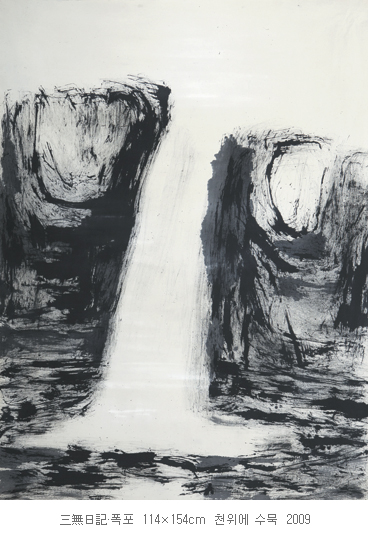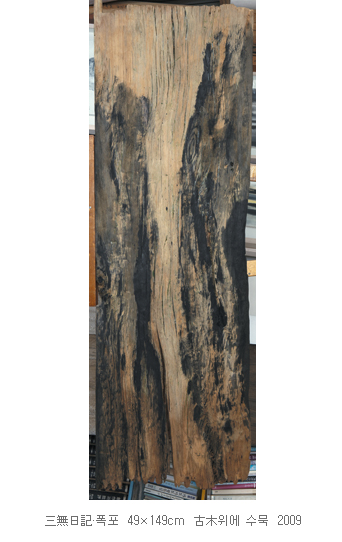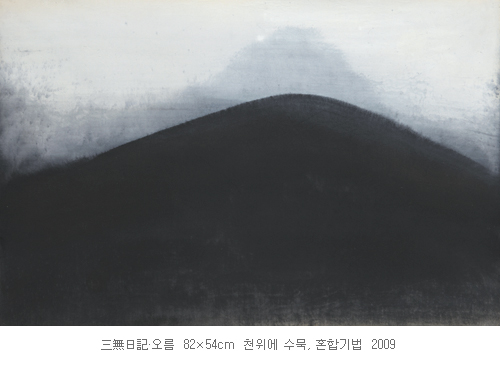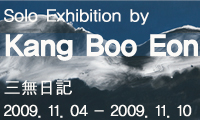상세정보
2009년 11월 4일부터 10일까지 공갤러리에서 자연의 소리를 듣는 작가 강부언의 개인전이 열린다.
자연의 소리를 쓸어 담다 김영호 | 중앙대교수, 미술평론가
강부언의 그림은 어느 수도승의 비질을 연상케 한다. 산중 사찰에 자리한 사각의 황토 마당을 돌며 쓸어내는 행위로서 비질이다. 매일 일상적으로 반복되는 비질은 자유롭지만 거기에는 구도자의 절제된 태도가 드러나기도 한다. 대지를 쓸어내는 수도승의 손놀림에 붓을 얹혀 먹을 첨가하고 호흡과 손놀림의 강약을 더하면 화가의 멋진 그림이 될 것이라는 상상이 드는 것이다. 그렇게 그려지는 그림은 명산 수목들이 발산하는 정기와 그 안을 살아가는 조충(鳥蟲)들의 세밀한 속삭임들이 담겨 있을 것이다. 화가의 그림 마당은 결국 자연의 소리를 쓸어 담아낸 명상의 터가 아닌가.
강부언은 자신이 화폭 앞에서 취하는 태도는 ‘자연의 소리를 듣는 것’이라 말한다. 제주의 거친 풍광과 그 안을 살아가는 생명 있는 것들의 소리에 귀를 기울이는 일이 작가가 그림을 그리는 이유라는 것이다. 그리고 작가는 그 소리를 화폭에 토해내듯 다시 펼쳐 낸다. 화산섬 제주의 자연이란 유유자적(悠悠自適)의 대상이 아니다. 큰 바람의 길목에 자리한 섬, 화용암분출에 의해서 형성된 돌의 땅, 그 기슭을 밤낮으로 부딪치는 파도의 아우성이 어우러져 대자연의 웅대한 에너지를 느끼게 하는 그런 자연이다. 작가는 그 자연의 소리를 듣고 그것을 화면에 표상해 그리는 것이다.

강부언의 그림은 광목이나 한지 그리고 때로는 고목의 판면 위에서 만들어 진다. 그의 화면이 사각의 황토마당과 다르지 않게 보이는 것은 실재로 그가 사용하는 붓이 모필 뿐만 아니라 싸리 등의 나뭇가지로 제작된 거친 도구이기 때문이다. 또한 그의 붓질 역시 대상의 외관을 모사하는 일에 국한되지 않고 화면과 만나는 행위와 그 정신성에 의미를 두고 있기 때문이다. 서리가 내려앉은 마당을 비질하는 수도승처럼 그의 화폭은 자기를 비워내는 수련의 터이며 사물의 형태보다는 그 내용이나 정신에 치중하여 그리는 사의(寫意)적 태도를 지향하고 있다.
강부언의 화면에 등장하는 주제들은 바다와 폭포 그리고 오름이며 그 자연을 살아가는 인간들의 주거지로서 초가와 돌담이다. 그러나 사의적 태도와 관점에 의해 그 주제들은 화면위에서 해체되고 화면과 융화되어 비대상적 흔적으로 변형된다. 구체적 대상으로서 자연의 외관은 화면위의 순수형태가 되고 이윽고 관념의 차원으로 넘어가기를 시도하는 것이다. 결국 작가가 표상하려는 것은 바다와 해송 그리고 폭포의 외상(外相)이 아니라 그것들을 지배하는 어떤 힘이다. 작가는 이 힘의 정체를 ‘자연에 거침없이 흐르는 활력성’이라 적고 있으며 그 생동감을 표현하려는 것이 자신의 목표라 말한다. 결국 작가에 있어 그림은 자연의 외관 저편에 자리해 삼라만상을 운용하는 법칙성을 그리려는 것이라 해도 좋을 것이다.
산수풍경이라는 가시적 형태로부터 비가시적 기운을 표상하는 일은 예술가들에게 주어진 특권이다. 그리고 그것은 시대에 따라 작가마다 다양한 방식으로 통해 실현되어 왔다. 사의적 태도를 견지하고 있는 강부언의 경우 화면과의 대질은 직접적인 방식을 취하고 있 다. 그는 밑그림 없이 화면과 대면하며, 화면과 붓이 즉자적인 만남은 화폭에 자유로운 흐름을 남긴다. 그의 풍경화에서 발견되는 흐름은 이른바 바람결이며 보는 이의 숨결을 열어주는 중요한 요인이라 생각된다. 수평으로 흐르는 바람결의 세기는 시간대와 계절에 따라 각각 다르게 표현된다. 구름이 머무는 여름날의 황혼이나 북풍이 몰아치는 겨울의 이미지는 작가의 손에 쥐어진 붓의 종류와 팔의 강약에 의해 그 밀도가 정해질 것이다. 때로는 세밀힌 터치로 작은 생명의 얼개를 잡아내고 때로는 싸리비로 내리친 것처럼 파도의 위세를 표현해 낸다.

강부언의 화면을 대체로 수평적인 흐름으로 충만하다. 하지만 구도의 수평적 성질을 강화하는 것은 화면 곳곳에 수직으로 세워진 해송의 둥치들이다. 강부언의 화면에 분배된 수평과 수직의 힘을 감지해 보는 일은 분명 즐거운 일의 하나라 생각한다. 우주의 형태를 유지하는 두개의 축으로서 수평과 수직은 자연을 구성하는 절대값으로 존재한다. 가령 대양의 끝에 펼쳐진 수평선과 그 위에 떠있는 배에서 내리는 집어등의 수직적 반영은 그가 그려내는 바다의 기운 혹은 작가가 표상하려는 자연의 법칙성의 차원에서 이해될 수 있다. 또한 그의 폭포그림은 자연에 담긴 수직적 기운의 정점을 나타내는 경우에 속한다.
이상에서 보듯 강부언의 작품은 자연의 소리에 귀를 기울이는 태도와 그 자연에서 발견한 에너지의 흐름 그리고 그것을 다시 화폭에 표상하는 일련의 과정을 거치며 완성된다. 작가가 터를 잡고 살아가는 제주의 자연은 그에게 이러한 노정을 제공하고 있으며 작가는 이를 겸허한 태도로 수용하려 한다. 인간으로 살아가면서도 인위적인 것을 최소화하고 자연적 의미를 찾으려는 태도는 분명 의미 있는 일이다. 작가 강부언의 경우 남종화 계열의 화가들이 빠지기 쉬운 관념의 덫에서 벗어나, 자신을 둘러싼 현실과 시대에 대한 치열한 성찰의 태도를 동시에 견지하고 있는 점에 특별히 주목할 필요가 있다.
2009. 10
 The Sound of the Nature is Swept and Contained
The Sound of the Nature is Swept and Contained Kim, Young-ho | Professor of Chung-Ang University, art critic
Kang Boo-eon's paintings are reminiscent of a monk's sweeping work. The monk sweeps around a rectangular ocher yard of a Buddhist temple located deep in the mountain. The sweeping work repeated every day is free, but it may reveal the monk's controlled attitude. We imagine that the artist would put a brush on the monk's sweeping hands and then, add the ink to render a rhythm of breathing and hand stroking, and thereby, he would produce a wonderful painting. Such painting might well contain the spirit of the trees on a famous mountain as well as the delicate whispers of the birds and insects living therein. Isn't the artist's painting work yard a place of meditation where the sound of the nature is swept and contained?
Kang Boo-eon talks about his attitude before the canvas. "It is a listening to the sound of the nature." The reason why he paints is because he wants to listen to the sound of the rough landscape of Jeju as well as that of the life living therein. And the artist unfolds the sound again, as if he were vomiting it onto the canvas. The nature of the volcano island Jeju does not cater to an easy and comfortable life. The island located at a corner of the strong wind route, the basalt terra formed by the lava erupted, and the roar of the surf crushing to the base of the island day and night. All these are combined to make you feel the splendid energy of the Great Nature. The artist listens to the sound of the nature to express it on the canvas.

Kang Boo-eon's painting is drawn on cotton cloth, Hanji and, occasionally the board of an old tree. The reason why his canvas looks much like an rectangular ocher yard is because he actually uses not only the hair pencils but also the rough tools made of the branches of such trees as bush clover. In addition, his brushing is not limited to description of objects but extended to expression of the acts meeting the canvas and their spirits. Like the monk sweeping the frost off the yard, he cultivates his mind on the canvas for his spiritual purification. The artist focuses on contents and spirit of the objects rather than their forms, while aiming towards a reflective attitude.
The themes emerging on Kang Boo-eon's canvas are ocean, fall and rising. In other words, his themes connote thatched houses and stone walls as the shelters for the human beings living their nature. However, due to his reflective attitude and viewpoint, those themes are disintegrated and integrated on the canvas to be transformed into some non-object traces. The look of the nature as a specific object becomes a pure form on his canvas, and after a while, the pure form attempts to go over to the dimension of conception. After all, what the artist wants to represent are not the external images of ocean, beach pine tree or fall but some power dominating them. The artist notes the identity of such power with 'vitality flowing over the nature unhindered,' and he says that his goal lies in expression of such vitality. After all, to the artist, painting may well be an act of depicting some law governing all things in the nature from a perspective outside the look of the nature.
Representing an invisible energy in a visible form or the landscape is a privilege given to the artists. And such invisible energy has been represented in different ways over time or depending on artists. As for Kang Boo-eon who keeps the reflective attitude, he faces the canvas with no base painting, and therefore, the meeting An Sich between canvas and brush leaves free flows on the canvas. The flows found on his landscape paintings are equated with the so-called wind, which is deemed an important factor opening our respiration. The strength of the wind flowing horizontally is expressed differently over time and seasons. The image of a summer twilight below the clouds or a severe winter day affected by the cold northern wind varies in terms of its intensity due to types of brushes or variations of his arm strength. Sometimes, a frame of a tiny life is captured with a fine brush touch and at other times, the power of the surf is expressed as if the canvas were struck hard by a bush-clover broom.

Kang Boo-eon's canvas is usually full of the horizontal flows. However, what intensify the horizontal nature of the scheme are beach pine tree groups standing vertically on many parts of the canvas. I think that sensing the horizontal and vertical powers distributed on Kang Boo-eon's canvas may result in a sense of pleasure. Horizon and verticality as two axes maintaining the form of the universe exist as the absolute values serving the nature. For example, the vertical reflection of the horizon unfolded at the end of the ocean and the fish-luring lights suspended vertically from the fishing boats may well be understood at the dimension of the marine energy depicted by the artist or the law of the nature the artist attempts to represent. And his 'fall' painting may be the climax of the vertical energy contained in the nature.
As discussed above, Kang Boo-eon's works are completed through a series of processes: attitude of listening to the sound of the nature, capture of the energy flows found in the nature, and representation of them on the canvas. The nature of Jeju where he works and lives provides him with such processes, and the artist tries to accommodate them humbly. The attitude of living a human life but trying to minimize the artificial and instead find some natural meanings must be significant. We need to give a special attention to Artist Kang Boo-eon's vehemently reflective attitude towards the reality and spirit of time surrounding him, while escaping from the trap of conception in which the Chinese Southern School painters may well fall.
October, 2009






